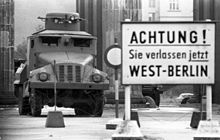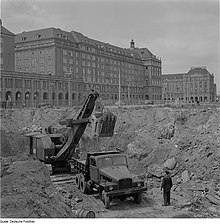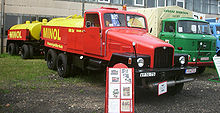IFA G5
| IFA | |
|---|---|
|
G5 of the People's Police with a box body
|
|
| G5 | |
| Manufacturer: | Motor vehicle plant "Ernst Grube" Werdau |
| Production period: | 1952-1964 |
| Previous model: | none |
| Successor: | G5 / 3 (series production not started) |
| Technical specifications | |
| Engines: | 6-cylinder diesel engine |
| Power: | 120 PS / 88 kW |
| Payload: | 5 t |
| Perm. Total weight: | 10 t |
The G5 is in the DDR developed and built three-axis Langhauber - trucks .
history
It was produced from 1952 (prototype) to 1964 in the VEB motor vehicle factory "Ernst Grube" Werdau . The work was part of the IFA and emerged from the Schumann works in Werdau , which were dissolved in 1945 . The development of the truck began in the Second World War at Vogtländische Maschinenfabrik AG (Vomag). Since the Soviet occupying forces had Vomag completely dissolved and dismantled shortly after the end of the war , development at Auto Union and Horch continued.
The vehicle was also intended for military use in the GDR . The "G" stands for terrain and the "5" for 5 t payload. A large number of additional devices could also be attached.
Compared to the three-axle Soviet ZIS-151 with 98 HP, the vehicle, which was comparatively well motorized with 120 HP, was probably slower off-road. Drivers described the G5 as a “lame box”.
technology

The G5 has three axles and is all-wheel drive (6 × 6), but the drive to the front axle can be switched off (6 × 4).
- Engine: 6 cylinder diesel engine with 120 hp
- Gearbox: 5-speed change gearbox with dog clutch
- Permissible payload: 5 t
- Top speed on the road: 80 km / h (according to manufacturer information 60 km / h)
- Top speed off-road: 40 km / h
- Designs / superstructures: dump trucks , cranes , cases (including workshop cases ), flatbed with tarpaulin, tanker , water cannons , various fire engines and others. In many cases, the construction was carried out at other companies in the GDR.
The driver's cab was produced in different versions, for example as a closed driver's cab, a driver's cab with a long cabin ( relay cabin for fire engines), a driver's cab with a fabric roof and a driver's cab with a foldable windscreen.
The G5 and H6 trucks , which were built around the same time in Werdau, have in part the same assemblies. In order to primarily improve the properties for off-road use, the G5 / 3, which was equipped with a more powerful engine, was developed, but was no longer built in series.
commitment


The main buyers for this truck were the KVP or NVA and the People's Police . The vehicles of the fighting groups of the working class and the version as a water cannon, which were used on August 13, 1961 during the construction of the Berlin Wall , became more popular.
Since there were not enough trucks in the GDR, G5s that had been decommissioned by the NVA were later used by agricultural production cooperatives and in business, for example as a fuel transporter for Minol . But the G5 was also used by the fire brigade , primarily as a tank tender (TLF 15) with a squadron cabin.
While five tons of payload were mostly sufficient for the army deployment and cross-country mobility was important, this only met the needs of the economy to a small extent. The ratio of effort and benefit did not correspond to the economic conditions. As a result, with the advent of alternative trucks, the G5 was barely used any more.
Further development
There were generations G5 / 1 and G5 / 2.
The successor to the G5, developed from scratch, was to be the G5 / 3. An air-cooled V8 diesel engine with 150 hp and a displacement of 12.5 liters was planned. The three-axle vehicle was to be fitted with single tires with a tire pressure control system. In 1958/59 and 1961 four functional models and two production models were built. In May 1962, development of the G5 / 3 was discontinued. The reason for this was the decision to mass-produce the W50 . The reasons for the demolition, however, are due to the economic situation in the GDR at the time. In particular, the engine development and the tires caused problems. In addition, the investments necessary for series production in the manufacturing plant in Werdau were viewed as too high in view of the low demand on the part of the NVA and the lack of export opportunities.
literature
- Christian Suhr: G5 - the three-axle vehicle from Werdau. Kraftakt publishing house, Reichenbach / V. Hall / S. 2007, ISBN 3-938426-04-7 .
- Christian Suhr: Commercial vehicles from Werdau. Verlag Klaus Rabe, Willich 2003, ISBN 3-926071-29-X .
- Günther Wappler: History of Zwickau and Werzeit commercial vehicle construction. Bergstrasse publishing house, Aue 2002.
- Frank-Hartmut Jäger: IFA-Hauber from Zwickau and Werdau (fire brigade archive). Verlag Technik, Berlin 1999, ISBN 3-341-01242-7 .




